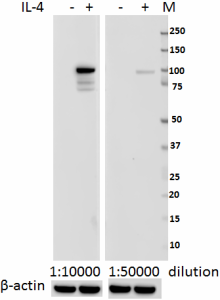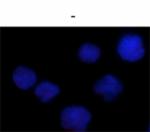- Clone
- A15137A (See other available formats)
- Regulatory Status
- RUO
- Other Names
- Signal transducer and activator of transcription 6, IL-4 Stat
- Isotype
- Mouse IgG1, κ
- Ave. Rating
- Submit a Review
- Product Citations
- publications

-

Total cell lysate (15 µg protein) from non-treated and 100 ng/mL recombinant human IL-4 treated Daudi cells (10 min treatment) were resolved by 4-12% Bis-Tris gel electrophoresis, transferred to nitrocellulose, and probed with 1:10000 (0.05 µg/mL) and 1:50000 (0.01 µg/mL) diluted purified anti-STAT6 phospho (Tyr641) antibody (clone A15137A) (upper). Proteins were visualized using 1:3000 diluted HRP goat anti-mouse-IgG secondary antibody (clone Poly4053) and chemiluminescence detection. Direct-Blot™ HRP anti-β-actin Antibody (1:2000 diluted, clone 2F1-1) was used as a loading control (lower). Lane M is the MW ladder. -

Daudi cells treated with 100 ng/mL recombinant human IL-4 were fixed with 4% paraformaldehyde (PFA) for 15 minutes, permeabilized with 0.5% Triton X-100 for 3 minutes, and blocked with 5% FBS for 60 minutes. Then the cells were intracellularly stained with 1 µg/ml anti-STAT6 phospho (Tyr641) antibody (clone A15137A) overnight at 4 degree followed by Alexa Fluor® 594 (red) conjugated goat anti-mouse IgG (clone Poly 4053) for one hour at room temperature. Nuclei were counterstained with DAPI (blue). The image was captured with a 60X objective. -

Daudi cells un-treated were fixed with 4% paraformaldehyde (PFA) for 15 minutes, permeabilized with 0.5% Triton X-100 for 3 minutes, and blocked with 5% FBS for 60 minutes. Then the cells were intracellularly stained with 1 µg/ml anti-STAT6 phospho (Tyr641) antibody (clone A15137A) overnight at 4 degree followed by Alexa Fluor® 594 (red) conjugated goat anti-mouse IgG (clone Poly 4053) for one hour at room temperature. Nuclei were counterstained with DAPI (blue). The image was captured with a 60X objective. -
Chromatin Immunoprecipitation (ChIP) was performed using Go-ChIP-Grade™ Protein G Enzymatic Kit by loading 3 µg of cross-linked chromatin samples from Ramos cells starved overnight and then treated with IL-4 with either A) 1:50 dilution of Go-ChIP-Grade™ Purified anti-STAT6 Phospho (Tyr641) (clone A15137A), or B) equal amount of Purified mouse Ig1, κ isotype control antibody (Cat. No. 401401), or C) competitor's ChIP-grade purified anti-STAT6 Phospho (Tyr641) antibody and D) equal amount of matched isotype control antibody as recommended by the manufacturer. The enriched DNA was purified and quantified by real-time qPCR using primers targeting human DMD gene region. The amount of immunoprecipitated DNA in each sample is represented as signal relative to the 5% of total amount of input chromatin.
| Cat # | Size | Price | Quantity Check Availability | Save | ||
|---|---|---|---|---|---|---|
| 690101 | 25 µg | $141 | ||||
| 690102 | 100 µg | $288 | ||||
STAT6 is a member of the signal transducer and activator of transcription (STAT) family, activating gene expression in response to IL-4 and IL-13 stimulation. Upon cytokine stimulation, the receptor is phosphorylated by the associated Janus Kinases (Jak), followed by recruiting cytoplasmic STAT6. The Tyr641 residue of STAT6 is, in turn, phosphorylated by Jak. Phosphorylated STAT6 forms homodimers, translocates to the nucleus, and regulates transcription of target genes. STAT6 plays crucial roles in differentiation of T helper 2 (Th2) cells, class switch of immunoglobulins in B cells, expression of cell surface markers such as MHC class II, and the development of allergic inflammation.
Product DetailsProduct Details
- Verified Reactivity
- Human
- Antibody Type
- Monoclonal
- Host Species
- Mouse
- Immunogen
- Human STAT6 peptide phosphorylated at Tyr641.
- Formulation
- Phosphate-buffered solution, pH 7.2, containing 0.09% sodium azide.
- Preparation
- The antibody was purified by affinity chromatography.
- Concentration
- 0.5 mg/ml
- Storage & Handling
- The antibody solution should be stored undiluted between 2°C and 8°C.
- Application
-
WB - Quality tested
ICC, ChIP - Verified - Recommended Usage
-
Each lot of this antibody is quality control tested by Western blotting. For Western blotting, the suggested use of this reagent is 0.01 - 0.05 µg per ml. For immunocytochemistry, a concentration range of 0.2 - 1.0 μg/ml is recommended. For ChIP applications, the suggested dilution is 1:50-1:100 by volume. It is recommended that the reagent be titrated for optimal performance for each application.
- Application Notes
-
This antibody recognizes STAT6 Phospho (Tyr641) in all three isoforms at 74, 82, and 94 kD. The predominant band detected is at 94 kD.
- RRID
-
AB_2715760 (BioLegend Cat. No. 690101)
AB_2715760 (BioLegend Cat. No. 690102)
Antigen Details
- Structure
- 847 amino acids, predicted molecular weight of 94 kD. Contains a SH2 domain responsible for phosphor-Tyrosine binding and dimerization.
- Distribution
-
Translocates to the nucleus when phosphorylated.
- Function
- STAT6 is a transcription factor, mediating IL-4 and IL-13 signaling.
- Interaction
- STAT6 interacts with CBP/p300 and NCOA1. Forms a homodimer or a heterodimer with other STAT family members.
- Cell Type
- B cells
- Biology Area
- Cell Biology, Immunology, Signal Transduction
- Molecular Family
- Nuclear Markers, Phospho-Proteins
- Antigen References
-
- Goenka S, et al. 2011. Immunol. Res. 50:87
- Wurster AL, et al. 2000. Oncogene. 19:2577
- Akira S, 1999. Stem Cells. 17:138
- Zamorano J, et al. 2005. J. Immunol. 174:2843
- David M, et al. 2001. Oncogene. 20:6660
- Takeda K, et al. 1996. Nature. 380:627
- Gene ID
- 6778 View all products for this Gene ID
- UniProt
- View information about STAT6 Phospho Tyr641 on UniProt.org
Related Pages & Pathways
Pages
Related FAQs
Other Formats
View All STAT6 Phospho (Tyr641) Reagents Request Custom Conjugation| Description | Clone | Applications |
|---|---|---|
| Purified anti-STAT6 Phospho (Tyr641) | A15137A | WB,ICC,ChIP |
Compare Data Across All Formats
This data display is provided for general comparisons between formats.
Your actual data may vary due to variations in samples, target cells, instruments and their settings, staining conditions, and other factors.
If you need assistance with selecting the best format contact our expert technical support team.
 Login/Register
Login/Register 












Follow Us